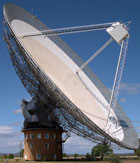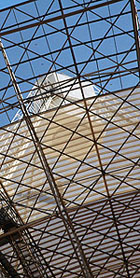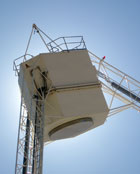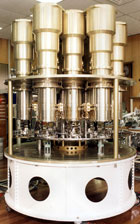How does a Radio Telescope Work?

In the PULSE@Parkes scheme you will use the Parkes radio telescope to make your observations. In this section you will learn the basics of how a single-dish radio telescope such as Parkes works.
A radio telescope is simply a telescope that is designed to receive radio waves from space. In its simplest form it has three components:
- One or more antennas to collect the incoming radio waves. Most antennas are parabolic dishes that reflect the radio waves to a receiver, in the same way as a curved mirror can focus visible light to a point.
- A receiver and amplifier to boost the very weak radio signal to a measurable level. These days the amplifiers are extremely sensitive and are normally cooled to very low temperatures to minimise interference due to the noise generated by the movement of the atoms in the metal (called thermal noise).
- A recorder to keep a record of the signal. Most radio telescopes nowadays record directly to some form of computer memory disk as astronomers use sophisticated software to process and analyse the data.
Let us see how these components work on the Parkes radio telescope.

The Antenna
Parkes has a parabolic dish antenna, 64 m in diameter with a collecting area of 3,216 m2. The dish is made up of aluminium panels supported by a lattice-work of supporting struts. To incoming radio waves from space, the dish surface acts in the same manner as a smooth mirror. The waves are reflected and focused into a feedhorn in the base of the telescope's focus cabin. The dish has a mass of 300 tonnes and distorts under its own weight as it points to different parts of the sky. Due to clever engineering design, however, this distortion is accounted for so that the radiowaves are always reflected to the focus cabin.

The telescope operates at frequencies from 440 MHz to 23 GHz which corresponds to radiowaves of 75 cm to 7 mm. For any radiowave to be reflected form the dish it must be smoother than a fraction of the wavelength. For the Parkes telescope the dish surface is accurate to within 1-2 mm of the best-fit parabola, allowing 7 mm radiowaves to be reflected.
Why is the dish so big?
The size of a dish determines the amount of incoming radiation that can be collected. The larger the collecting area, the fainter the source that can be detected. Parkes is a 64 m antenna, the second-largest single dish in the southern hemisphere.
For a single-dish radio telescope the size of the dish also determines the field-of-view of the telescope. When a single receiver is used the Parkes telescope has a beamwidth of about 15 arc minutes, half the size of the Moon in the sky.
Receivers

The weak radio signals are channeled by the feedhorn into a receiver located in the focus cabin located at the top of the telescope. Radio receivers amplifies the incoming signal about a million times. Parkes has a suite of receivers that are optimised for different frequency ranges and applications. The receivers are cryogenically cooled, typically with helium gas refrigerators that cool them to about 10 Kelvin (-260° C) to minimise the thermal noise in the electronics that would otherwise swamp the incoming signal.
For pulsar observations at Parkes observers typically use either the central beam of the Parkes Multibeam receiver, the HOH receiver, both of which detect 21 cm (1420 MHz) radiation or the Dual-Band receiver that can observe at 10 cm and 50 cm simultaneously.
Recorders
The amplified signals are carried by fibre optic cable from the recievers in the focus cabin down into the tower where they are stored on computer disks. Depending on the type of observation some processing of the data is performed on-site using computers in the tower. For pulsar observations the rate at which data is received can be extremely high.
| Telescope Statistics | |
|---|---|
| Diameter of dish | 64 m |
| Collecting area of dish | 3,216 m2 |
| Height to top of focus cabin | 58 m |
| Focal length | 27.4 m |
| Weight of dish | 300 tonnes |
| Weight above control tower | 1,000 tonnes |
| Maximum tilt | 60° |
| Time to maximum tilt | 5 minutes |
| Time for 360° rotation | 15 minutes |
| Surface accuracy | 1-2 mm difference from best-fit parabola |
| Pointing accuracy | 11 arcseconds rms in wind |
| Maximum operating wind speed | 35 km per hour |
| Motors | 4 × 15 hp 480 volt DC 40,000:1 gear ratios |
| Operating frequencies | |
| 440 and 660 and 1420 MHz (pulsar timing and surveys) | |
| 1420 MHz (atomic hydrogen in galaxies) | |
| 6 and 12 and 23 GHz (methanol and water masers) | |
| 23 GHz (ammonia in star-forming regions) | |
